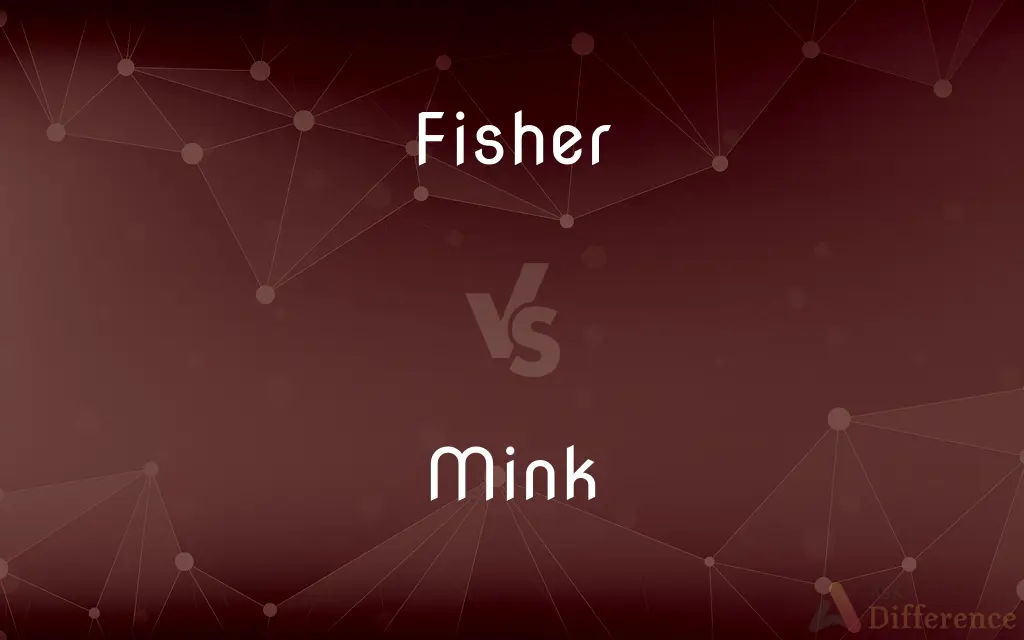Fisher vs. Mink — What's the Difference?
By Tayyaba Rehman & Urooj Arif — Updated on March 28, 2024
A fisher is a large, dark, forest-dwelling mustelid known for hunting and agility, while a mink is smaller, often semi-aquatic, prized for its fur.

Difference Between Fisher and Mink
Table of Contents
ADVERTISEMENT
Key Differences
Fishers, part of the mustelid family, are larger predators renowned for their climbing skills and adaptability in various forested habitats. They have a reputation for being one of the few animals that hunt porcupines. Fishers possess a dense fur coat, primarily dark brown, and are found across North America. They play a significant role in their ecosystems, controlling the populations of smaller mammals and birds. In contrast, minks are smaller mustelids with sleek bodies, known for their luxurious fur, which has made them a target for fur farming. Minks live in both wild and farmed environments, often near water bodies, and their diet includes fish, amphibians, and small mammals.
While fishers are solitary and primarily terrestrial, though capable climbers, minks are often found near rivers, lakes, and marshes, showcasing their strong swimming abilities. This difference in habitat preference underscores the adaptations each species has developed for survival and hunting. Fishers tend to have larger territories and require extensive forested areas to thrive, reflecting their need for space and diverse hunting grounds. On the other hand, minks, being smaller, can adapt to a variety of environments, including areas impacted by human activity, though they still prefer access to water for hunting.
The fur of fishers and minks also serves different roles and perceptions in human society. Fisher fur, while valuable, is less commonly used in the fashion industry compared to mink fur, which is highly sought after for its softness, warmth, and status symbol qualities. This demand for mink fur has led to extensive farming of minks, raising concerns about animal welfare and environmental impacts. In comparison, fishers have been less affected by direct human exploitation, although habitat loss and fragmentation pose significant threats to their populations.
Conservation efforts for both species vary due to their interactions with humans and habitats. Fishers have been subject to re-introduction and habitat protection efforts to sustain their populations, especially in areas where they were previously extirpated. Minks, especially wild populations, face threats from habitat loss, pollution, and competition with escaped farmed minks, which can also spread diseases. The conservation of minks focuses on protecting natural habitats and regulating fur farming practices to mitigate these impacts.
Despite being from the same family, the ecological roles, behaviors, and human interactions of fishers and minks highlight the diversity within the Mustelidae family. Understanding these differences is crucial for their conservation and for managing human impacts on their populations and ecosystems.
ADVERTISEMENT
Comparison Chart
Size
Larger, up to 13 lbs (6 kg) and 40 inches (102 cm) including tail.
Smaller, up to 3.5 lbs (1.6 kg) and 28 inches (71 cm) including tail.
Habitat
Forests across North America.
Near water bodies, both wild and farmed.
Diet
Small mammals, birds, occasionally porcupines.
Fish, amphibians, small mammals.
Behavior
Solitary, terrestrial and arboreal.
Solitary, semi-aquatic.
Fur Use
Valued but less commonly used than mink.
Highly prized in fashion for its softness.
Conservation
Re-introduction efforts, habitat protection.
Habitat protection, regulation of fur farming.
Compare with Definitions
Fisher
Has a dark brown fur coat, valuable but not as sought after as mink.
Fishers' fur is used in garments, though it's less common than mink fur.
Mink
Wild populations are threatened by habitat loss and pollution.
Conservation efforts for minks include protecting wetlands and regulating pollution.
Fisher
A large mustelid predator adept in forests.
The fisher climbed the tree effortlessly to escape the threat on the ground.
Mink
A smaller, often semi-aquatic mustelid with luxurious fur.
The mink slid into the water silently, hunting for fish.
Fisher
Subject to conservation efforts focused on habitat and population.
Fishers have been reintroduced in areas where they were previously extirpated.
Mink
Lives near water and is known for swimming abilities.
Minks are excellent swimmers, often diving to catch their prey.
Fisher
Prefers extensive forested habitats for territory.
Conservationists are working to preserve large forest areas to support fisher populations.
Mink
Fur is a major fashion industry commodity, valued for its softness and warmth.
Mink coats are considered a luxury item in the fashion world.
Fisher
Known for its agility and ability to hunt porcupines.
Fishers are one of the few predators that can successfully hunt porcupines by attacking their faces.
Mink
Farmed extensively for its fur, leading to ethical and environmental concerns.
Animal rights activists have raised concerns about the conditions in mink fur farms.
Fisher
Large dark brown North American arboreal carnivorous mammal
Mink
Either of two semiaquatic mustelid carnivores, Mustela lutreola of Europe or Neovison vison of North America, having a pointed snout, short legs, and partly webbed toes. The North American species is bred for its commercially valuable fur.
Fisher
A person who catches fish, especially for a living or for sport; a person engaging in the pastime of fishing.
Mink
Mink are dark-colored, semiaquatic, carnivorous mammals of the genera Neogale and Mustela and part of the family Mustelidae, which also includes weasels, otters, and ferrets. There are two extant species referred to as "mink": the American mink and the European mink.
Fisher
A North American marten, Martes pennanti, that has thick brown fur.
Mink
The soft thick lustrous fur of a mink.
Fisher
The fur of Martes pennanti.
Mink
A coat, stole, or hat made of this fur.
Fisher
One who fishes.
Mink
(plural mink or minks) Any of various semi-aquatic, carnivorous mammals in the Mustelinae subfamily, similar to weasels, with dark fur, native to Europe and America, of which two species in different genera are extant: the American mink (Neovison vison) and the European mink (Mustela lutreola).
Fisher
A carnivorous animal of the Weasel family (Mustela Canadensis); the pekan; the "black cat."
Mink
(plural mink) The fur or pelt of a mink, used to make apparel.
Fisher
Someone whose occupation is catching fish
Mink
(plural minks) An article of clothing made of mink.
Mink
(plural minks) An individual with poor personal hygiene; a smelly person.
Mink
A carnivorous mammal of the genus Mustela (foremrly Putorius), allied to the weasel. The European mink is Mustela lutreola. The common American mink (Mustela vison) varies from yellowish brown to black. Its fur is highly valued. Called also minx, nurik, and vison.
Mink
The fur of the mink{1}. Together with sable, it is one of the most expensive furs not taken from endangerd species. When the fur is taken from animals grown on a farm, it called ranch mink.
Mink
The expensive fur of a mink
Mink
Fur coat made from the soft lustrous fur of minks
Mink
Slender-bodied semiaquatic mammal having partially webbed feet; valued for its fur
Common Curiosities
Why is mink fur more popular than fisher fur?
Mink fur is softer, warmer, and has been historically more desirable in the fashion industry.
Which is bigger, a fisher or a mink?
A fisher is significantly larger than a mink.
Are fishers and minks found in the same habitats?
While both can live in forested areas, minks are more closely associated with aquatic environments.
What are the main threats to fishers and minks?
Fishers face habitat loss and fragmentation, while minks are affected by habitat loss, pollution, and issues related to fur farming.
Do fishers and minks have natural predators?
Both species have natural predators, including larger mammals and birds of prey, but human activities are a significant threat.
Can fishers and minks swim?
Minks are known for their swimming abilities, whereas fishers are primarily terrestrial but can swim.
How do conservation efforts for fishers and minks differ?
Conservation for fishers focuses on habitat preservation and reintroduction, while for minks, it includes habitat protection and fur farming regulation.
Can fishers and minks be kept as pets?
Neither fishers nor minks are suitable as pets due to their wild nature and specific care needs.
Are fishers aggressive towards humans?
Fishers are generally shy and avoid human contact, though they can defend themselves if threatened.
How do fishers and minks contribute to their ecosystems?
Both play important roles in controlling the populations of smaller animals, thus contributing to the balance of their respective ecosystems.
Share Your Discovery

Previous Comparison
Beyoncé vs. Rihanna
Next Comparison
Immoral vs. IndecentAuthor Spotlight
Written by
Tayyaba RehmanTayyaba Rehman is a distinguished writer, currently serving as a primary contributor to askdifference.com. As a researcher in semantics and etymology, Tayyaba's passion for the complexity of languages and their distinctions has found a perfect home on the platform. Tayyaba delves into the intricacies of language, distinguishing between commonly confused words and phrases, thereby providing clarity for readers worldwide.
Co-written by
Urooj ArifUrooj is a skilled content writer at Ask Difference, known for her exceptional ability to simplify complex topics into engaging and informative content. With a passion for research and a flair for clear, concise writing, she consistently delivers articles that resonate with our diverse audience.













































